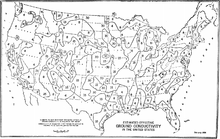Ground conductivity

Ground conductivity refers to the electrical conductivity of the subsurface of the earth. In the International System of Units (SI) it is measured in millisiemens per meter (mS/m).
Radio propagation
Ground conductivity is an extremely important factor in determining the field strength and propagation of surface wave (ground wave) radio transmissions. Low frequency (30–300 kHz) and medium frequency (300–3000 kHz) radio transmissions are particularly reliant on good ground conductivity as their primary propagation is by surface wave.[1] It also affects the real world radiation pattern of high frequency (3-30 MHz) antennas, as the so called "takeoff angle" is not an inherent property of the antenna but a result of a ground reflection.[2] For this reason ITU publishes an extensive world atlas of ground conductivities.[3]
Other uses
Ground conductivity is sometimes used in determining the efficiency of a septic tank, using electromagnetic induction, so that contaminants do not reach the surface or nearby water supplies.[4]
References
- ↑ "Recommendation ITU-R P.368-7 Ground-wave propagation curves for frequencies between 10 kHz and 30 MHz" (DOC). International Telecommunication Union (ITU). 1992. Retrieved 2015-10-28.
- ↑ Kazimierz Siwiak KE4PT (April 2016). "Ground influence on antenna patterns". QST. American Radio Relay League: 41–42.
- ↑ "Recommendation ITU-R P.832-2, World Atlas of Ground Conductivities" (PDF) (PDF). International Telecommunication Union (ITU). 1999. Retrieved 2015-10-28.
- ↑ Taylor, Rick; Lee, Doolittle (June 2003). "Ground conductivity survey of a septic system during and after failure". Retrieved 2008-02-10.
External links
- Ground conductivity maps in the United States (provided by the Federal Communications Commission and includes large scale map)
- Measurement of the ground conductivity and relative permittivity with high frequency using an open wire line (OWL) (Practical example with network analyzer and mathematics for the conversion)